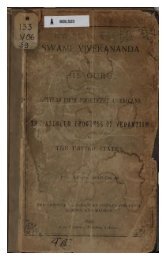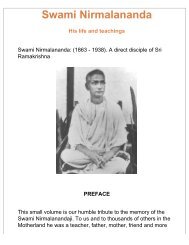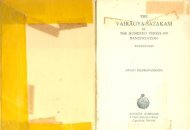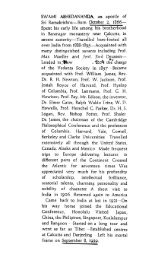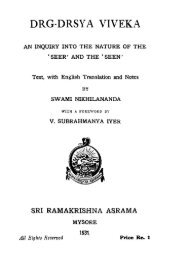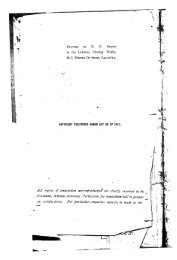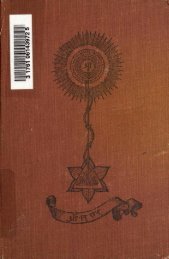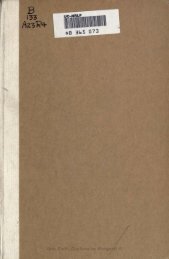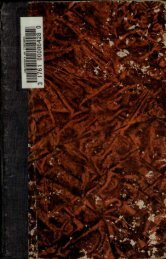<strong>Practical</strong> <strong>Vedanta</strong>omnipresent, the infinite, cannot be two. If there are two infinites A and B, theinfinite A would limit the infinite B, because the infinite B is not the infinite A,and the infinite A is not the infinite B. Difference in identity means exclusion, andexclusion means limitation. Therefore, A and B, limiting each other, cease to beinfinites. Hence, there can be but one infinite, that is, one Purusha.Now we will take up our x and y and show they are one. We have shown howwhat we call the external world is x + mind, and the internal world y + mind; x andy are both quantities unknown and unknowable. All difference is due to time,space, and causation. These are the constituent elements of the mind. No mentalityis possible without them. You can never think without time, you can neverimagine anything without space, and you can never have anything withoutcausation. These are the forms of the mind. Take them away, and the mind itselfdoes not exist. All difference is, therefore, due to the mind. According to <strong>Vedanta</strong>,it is the mind, its forms, that have limited x and y apparently and made themappear as external and internal worlds. But x and y, being both beyond the mind,are without difference and hence one. We cannot attribute any quality to them,because qualities are born of the mind. That which is qualityless must be one; x iswithout qualities, it only takes qualities of the mind; so does y; therefore these xand y are one. The whole universe is one. There is only one Self in the universe,only One Existence, and that One Existence, when it passes through the forms oftime, space, and causation, is called by different names, Buddhi, fine matter, grossmatter, all mental and physical forms. Everything in the universe is that One,appearing in various forms. When a little part of it comes, as it were, into thisnetwork of time, space, and causation, it takes forms; take off the network, and itis all one. Therefore in the Advaita philosophy, the whole universe is all one in theSelf which is called Brahman. That Self when it appears behind the universe iscalled God. The same Self when it appears behind this little universe, the body, isthe soul. This very soul, therefore, is the Self in man. There is only one Purusha,the Brahman of the <strong>Vedanta</strong>; God and man, analysed, are one in It. The universe isyou yourself, the unbroken you; you are throughout the universe. "In all hands youwork, through all mouths you eat, through all nostrils you breathe through allminds you think." The whole universe is. you; the universe is your body; you arethe universe both formed and unformed. You are the soul of the universe and itsbody also. You are God, you are the angels, you are man, you are animals, you arethe plants, you are the minerals, you are everything; the manifestation ofeverything is you. Whatever exists is you. You are the Infinite. The Infinite cannotbe divided. It can have no parts, for each part would be infinite, and then the partwould be identical with the whole, which is absurd. Therefore the idea that you areMr. So-and-so can never be true; it is a day-dream. Know this and be free. This isthe Advaita conclusion. "I am neither the body, nor the organs, nor am I the mind;I am Existence, Knowledge, and Bliss absolute; I am He." This is true knowledge;all reason and intellect, and everything else is ignorance. Where is knowledge forme, for I am knowledge itself! Where is life for me, for I am life itself! I am sure Ifile:///C|/Documents%20and%20Settings/Chitra%20Selv...ksBySwami/<strong>Practical</strong><strong>Vedanta</strong>/<strong>Practical</strong><strong>Vedanta</strong>PDF.html (100 of 113)2/26/2007 12:24:34 AM
<strong>Practical</strong> <strong>Vedanta</strong>live, for I am life, the One Being, and nothing exists except through me, and inme, and as me. I am manifested through the elements, but I am the free One. Whoseeks freedom? Nobody. If you think that you are bound, you remain bound; youmake your own bondage. If you know that you are free, you are free this moment.This is knowledge, knowledge of freedom. Freedom is the goal of all nature.<strong>Practical</strong> <strong>Vedanta</strong>14. The Goal(Delivered in San Francisco, March 27, 1900)I shall give you a résumé of the Sânkhya philosophy, through which we have beengoing. We, in this lecture, want to find where its defects are, and where <strong>Vedanta</strong>comes in and supplements it. You must remember that according to Sankhyaphilosophy, nature is the cause of all these manifestations which we call thought,intellect, reason, love, hatred, touch, taste, and matter. Everything is from nature.This nature consists of three sorts of elements, called Sattva, Rajas, and Tamas.These are not qualities, but elements, the materials out of which the wholeuniverse is evolved. In the beginning of a cycle these remain in equilibrium; andwhen creation comes, they begin to combine and recombine and manifest as theuniverse. The first manifestation is what the Sankhya calls the Mahat orIntelligence, and out of that comes consciousness. According to Sankhya, this isan element (Tattva). And out of consciousness are evolved Manas or mind, theorgans of the senses, and the Tanmâtras (particles of sound, touch, etc.). All thefine particles are evolved from consciousness, and out of these fine particles comethe gross elements which we call matter. The Tanmatras cannot be perceived; butwhen they become gross particles, we can feel and sense them.The Chitta, in its threefold function of intelligence, consciousness, and mind,works and manufactures the forces called Prâna. You must at once get rid of theidea that Prana is breath. Breath is one effect of Prana. By Prana are meant thenervous forces governing and moving the whole body, which also manifestthemselves as thought. The foremost and most obvious manifestation of Prana isthe breathing motion. Prana acts upon air, and not air upon it. Controlling thefile:///C|/Documents%20and%20Settings/Chitra%20Selv...ksBySwami/<strong>Practical</strong><strong>Vedanta</strong>/<strong>Practical</strong><strong>Vedanta</strong>PDF.html (101 of 113)2/26/2007 12:24:34 AM
- Page 1 and 2:
Practical VedantaPractical VedantaP
- Page 3 and 4:
Practical Vedantaworld. If I am a s
- Page 5 and 6:
Practical Vedantadifference is only
- Page 7 and 8:
Practical VedantaThe ideal of faith
- Page 9 and 10:
Practical Vedantamoment of our live
- Page 11 and 12:
Practical Vedantaof the Christs and
- Page 13 and 14:
Practical Vedanta"This life is Brah
- Page 15 and 16:
Practical Vedantadark fifteen days,
- Page 17 and 18:
Practical Vedantalife. This is the
- Page 19 and 20:
Practical Vedantaeverything would b
- Page 21 and 22:
Practical Vedantait is only through
- Page 23 and 24:
Practical Vedantawhich is that subt
- Page 25 and 26:
Practical Vedantanoumenon and pheno
- Page 27 and 28:
Practical Vedantato which is the be
- Page 29 and 30:
Practical VedantaAbsolute.The finit
- Page 31 and 32:
Practical Vedantawhich is not the q
- Page 33 and 34:
Practical Vedantaexperience that th
- Page 35 and 36:
Practical Vedantafulfilled. The Jiv
- Page 37 and 38:
Practical Vedantabetween the pure r
- Page 39 and 40:
Practical Vedantacome out straight.
- Page 41 and 42:
Practical Vedantawar with one anoth
- Page 43 and 44:
Practical Vedantanobody could under
- Page 45 and 46:
Practical VedantaMy idea, therefore
- Page 47 and 48:
Practical Vedantathe same methods.
- Page 49 and 50: Practical Vedantavarious minds, all
- Page 51 and 52: Practical Vedantabrotherhood; but t
- Page 53 and 54: Practical Vedantabrotherhood, but w
- Page 55 and 56: Practical Vedantawe all go with ves
- Page 57 and 58: Practical Vedantareason. What can y
- Page 59 and 60: Practical Vedantabeen preached in t
- Page 61 and 62: Practical Vedantathe husband kisses
- Page 63 and 64: Practical Vedantaof the knowledge a
- Page 65 and 66: Practical Vedantafor those who only
- Page 67 and 68: Practical Vedantasun exists because
- Page 69 and 70: Practical Vedantaof death was pleas
- Page 71 and 72: Practical VedantaGod. We must learn
- Page 73 and 74: Practical Vedantaa plague comes, it
- Page 75 and 76: Practical VedantaAtman? "As with a
- Page 77 and 78: Practical Vedantathat immortal One,
- Page 79 and 80: Practical Vedantaand the third egoi
- Page 81 and 82: Practical VedantaWitness of the uni
- Page 83 and 84: Practical VedantaPractical Vedanta1
- Page 85 and 86: Practical Vedantaeternal ; every ot
- Page 87 and 88: Practical Vedantafaculty, Buddhi, w
- Page 89 and 90: Practical VedantaPractical Vedanta1
- Page 91 and 92: Practical Vedantastepping-stone to
- Page 93 and 94: Practical Vedantarecognition? Findi
- Page 95 and 96: Practical Vedantasentient." This is
- Page 97 and 98: Practical Vedantaessentially differ
- Page 99: Practical Vedantaexistence is limit
- Page 103 and 104: Practical Vedantasee from Kapila's
- Page 105 and 106: Practical Vedantalimitation, but th
- Page 107 and 108: Practical Vedantaperfect, infinite,
- Page 109 and 110: Practical Vedantaindividuality, of
- Page 111 and 112: Practical Vedantarepeat [something]
- Page 113: Practical Vedantaperson who dies in



